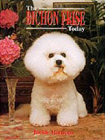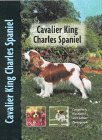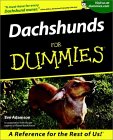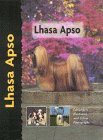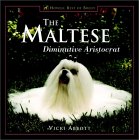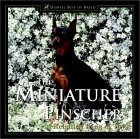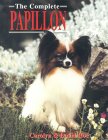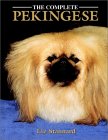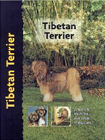Books on animals: Dogs
Dog Breeds: Small Companion Breeds
(Bichons, Cavalier King Charles, Chihauhauas, Dachshunds, Italian Greyhounds, Japanese Chins, Lhasa Apso, Maltese, Miniature Pinschers, Papillons, Pekinese, Pomeranians, Pugs, Shih Tzu, Tibetan Terriers, and Yorkshire Terriers)
If you want to buy a book, clicking on the book cover will take you directly to that book on the Amazon.co.uk web site.
See also:
- Dogs in recent history and different cultures
- Books on origins, canine evolution and wolves
- Behaviour (canine ethology and behavioural problems)
- Puppy and manners training
- Breeding, grooming and kennel management
- Fiction dealing with dogs
- Skill training: Agility and training games
- Skill training: Sheepdog, gundog and scent work
General overview
The dogs we have put in this category may be small, but they have big personalities. They tend to be scaled down versions of bigger breeds, so retain many characteristics of that breed type, and it's difficult to generalise about their characters, except to say that they are all dog, and love being taken for walks by their companions. Small dogs do need particular care with their socialization. They need to learn how to get on with other dogs, large and small, but it's easier if they are socialized first with puppies of smaller breeds and well-behaved larger dogs, since large breed pups can be a little too rough and boisterous with them. Many small breed dogs are, however, very good with other dogs - Cavalier King Charles are good flirts, and rarely trigger aggression. Dachshunds and Yorkies tend to be fearless, able to put bigger breeds in their place if needed. These breeds also need some protection from small children, who may try to pick them up and carry them clumsily, and otherwise take liberties with them that they would not take with bigger dogs. Well-trained small dogs are usually very good companions for older children, however, because they can easily be walked by a child. They are also good companions for older people who may not have the mobility and muscle power they once had. Some small breeds, like dachshunds, can still demand a lot of skill in training, since a lot of willpower can be packed into a small body!
Good manners are best taught from puppyhood, because it's easier, but adult rescue dogs can still learn fast. The best time to teach good manners to a rescue dog is as soon as the dog arrives. That is when the dog is watching you to learn what the rules are. It's tempting to spoil the dog a bit, because you feel sorry for him or her. But it's kinder in the long run to let the dog know gently and firmly what you consider to be appropriate behaviour. Rescue centres usually have their own behaviourists and provide ongoing help for adopters. Gwen Bailey's 'The Rescue Dog' is also full of good advice.
The smaller breeds are much less likely to inflict life-threatening bites, or pull their handlers over than are bigger dogs, but this sometimes means that owners are a little lax about training. It's well worth taking small dogs to training classes. A well-trained small dog is a real treat to be with, but small dogs are often perceived as yappy, nippy and unstable. Much of the problem is that they tend to get less training than the bigger breeds, and are allowed to take more liberties when they are pups. Bite inhibition is important for all dogs. Small dogs may not worry their owners when they nip, but they can worry the postman, and small children. Yappy little dogs that rush up to people are much more at risk from being kicked than bigger dogs, and a kick can kill them, so training is very important for their own protection. Little dogs can also be yappier and nervier if they don't get enough exercise. Exercise helps all dogs to behave well, rather than rushing round the room making a lot of noise. You may not be mobile enough to take your dog out every day, or you may be too busy. However, one advantage of a small dog is that it's much easier to find someone to walk the dog for you. Small dogs can also be kept fit and happy by playing games like retrieve in your garden. You can train the dog so that he does all the running, and you just sit and throw the ball. Not all dogs are natural retrievers, but most can learn to play ball, especially if they are taught when they are young. Some small breeds, like King Charles Cavaliers, make excellent agility dogs, with the jumps lowered for them. These breeds are especially suited to active children who understand dogs enough to be gentle with them. You can find books on agility and advanced training, here.
Some small dogs can attach themselves firmly to one person in the household, and may be rude to other people. This is partly a training issue. It may also be that some men feel reluctant to take out small fluffy dogs, yet walks are very good for bonding, so the dogs tend to bond more with the women of the household. One solution is to give the fluffball a butch name like Fang, which is only used when dog and man are out on walks together, preferably without the lady owner. Once little Fang realises that boyfriend or husband is his only ally in the big wide world, he is more likely to see him as a friend in the home, and less likely to sit on his lady owner's lap and growl at her partner's approach.
Common health problems include knee trouble, and bad teeth. The dental problems common to small breeds probably arise because small companion dogs often spend a lot of time at home with doting owners, and are very good at begging for food. Whether or not you let your little dog beg is up to you, but...they are just as happy eating savoury foods as they are sweet food, and sugary foods will tend to rot their teeth! You can use very small pieces of kibble as training treats for some small dogs, though others, especially Yorkies, may need very special treats to interest them. You need to feed commercial treats sparingly, because they can be very fatty, and can sometimes upset small dogs' digestion. Always give tiny titbits so the dog doesn't get too fat, another common problem with small breeds as they age. Many of the breeds with short legs and relatively long backs are prone to back trouble, so are not suitable for households where small children could pick them up roughly and injure their backs.
Many breeds in this category are unfortunately described by the UK Kennel Club as 'toy breeds'. Hrumph. Dogs are not animated furry toys! You take on a real dog when you take on one of these breeds. Two breeds that you might expect to find here, Miniature Poodles and Schnauzers are with their larger cousins in 'Other Dogs'.

This Is a Bichon Frise
Bichon Frise dogs are often recommended for first-time owners, and they are certainly very cute and friendly dogs, who want to say hello to everybody. They are little fluffballs, often mistaken for poodles, and they have some poodle in their ancestry. Their muzzles aren't as pointy as a poodles, and they tend to be livelier. They usually get on very well with children, though since they are small dogs, children need to remember to be kind and gentle with them.
Other dogs seem to like Bichons, which is just as well, since Bichons like to go up to other dogs to greet them, and don't always hear their owners calling them back. Bichon Frises love walks, though they can be happy running round a garden, so long as they have human company. They do need regular grooming to avoid mats, though it's easier give them a short trim so that grooming is less necessary. Like poodles, they don't shed much, and are often recommended for people with allergies, though there is no guarantee that an allergic person will not be allergic to a Bichon Frise.

The Bichon Frise Today (A Ringpress Dog Book of Distinction)
This is an up-to-date guide to Bichons, which is well written and clear enough for novices, while containing enough information to interest experienced owners. There is help with showing, as well as general care, and an account of the history of the breed. There's a lot of advice on grooming, which is so important for these dogs, due to their tendency to mat. This book is also well-illustrated.

Bichon Frise: An Owner's Companion
Chris Wyatt is active in the Bichon show world, and her advice on showing and grooming is especially useful for Bichon Frise owners who want to go this route. This is a very clearly written and well-illustrated guide to the breed, which has appeal to both novices and experienced owners. Wyatt wears her knowledge lightly, the book is both very well researched, and has a light, humorous touch.

Bichon Havanese (Pet Love)
The Bichon Havanese is very similar to the Bichon Frise, and is related, but the Bichon Havanese has more of a colour range, and a less curly coat. Like the Bichon Frise, the Bichon Havanese is an active, fun-loving, sociable dog, which likes attention and learns fast, and is generally very good with children. These dogs also need a short trim so that grooming is not too much of a chore, and they don't shed much. Common health problems include eye trouble (eg cataracts), skin sensitivities, and luxating patella (kneecap problems), though again they are generally healthy and long-lived, like Bichon Frises.
This is a very well illustrated introduction to the breed, which is suitable for novice owners. There's an interesting account of the history of the breed, as well as help with general care, including grooming.

Cavalier King Charles Spaniel
Cavalier King Charles Spaniels, are delightful little dogs, lively, affectionate and versatile. They are happy to be companion dogs, and are favourites with children and older people, because they don't pull your arm off when you take them out, or try to pick fights with all the local dogs. Small children may need to learn how to handle them gently, since Cavvies tend not to defend themselves when they are roughly handled. They are one of the safest breeds with children, and adore attention from young humans.

Cavalier King Charles Spaniels Today
This breed guide is very much a book geared to people interested in showing and breeding Cavalier King Charles Spaniels, rather than mere pet owners. There is a lot of detail on the breed’s history, famous Cavaliers, the breed standard, colours and markings, all this in both the UK and abroad. There are three chapters on breeding and rearing Cavaliers, and a chapter on health care. Lovers of this breed will of course find such a detailed history fascinating, and will pause to gaze adoringly at photos of famous cavaliers.

The Cavalier King Charles Spaniel (The World of Dogs)
This book is an in-depth breed guide to the Cavalier King Charles Spaniel. There is a lot of information on genetics which is of interest to people wanting to buy a healthy pup, as well as people wanting to breed from their dogs. There's also help with grooming and showing Cavvies. The advice on general care is also well explained, and the illustrations are good.

The Cavalier King Charles Spaniel
This book is a very informative guide to the Cavalier King Charles Spaniels, which is of particular interest to anyone planning on breeding Cavaliers. It is also a very helpful guide for would-be owners who are choosing a Cavalier King Charles puppy. There is helpful advice on feeding and training, and a full account of the breed's history.

Chihuahuas For Dummies
Chihuahuas are very special little dogs, which can be kept in city apartments, though these dogs do like to have access to a garden, where they can take the sun in the summer. Many of the rude things that are said about them are true- they do tend to yap a lot when they are worried about a threat, and even yap when it has gone, just to make sure it doesn't come back. However, they can also spend hours happily snoozing beside you, without uttering a sound, and are ideal lap dogs, providing warmth in winter.

Dachshunds for Dummies
Dachshunds are sometimes classed as hounds, and were also used as earth dogs in Germany, where they originated, so they have much in common with terriers. Different types of dachshunds have been developed, with smooth, long, or wiry coats, and standard or miniature sizes. All types of dachshund tend to be bold and independent dogs - they are hunting dogs, so like to take decisions for themselves - and they also tend to bond closely with their owners.

Italian Greyhound : A Complete and Reliable Handbook
Italian Greyhounds are very cute little sighthounds, which stay playful long after puppyhood. They have long been bred as companion dogs, and though they retain their sighthound instincts as hunters, and like to chase small animals, they are also trainable.
They need gentleness and consistency in training, and can switch off if their handlers lose patience. Italian Greyhounds are good sources of warmth in winter, and are clean, elegant and graceful. They don't take up much room - they are smaller and more refined-looking than whippets - nor do they cost a lot in food, but they are agile, and can be good escape artists.
Read more: Italian Greyhound : A Complete and Reliable Handbook

The Complete Japanese Chin (Book of the Breed)
The Japanese Chin is also called the Japanese Spaniel, and has many similarities with the King Charles Cavalier Spaniel, such as a history of being bred for companionship, and a popular breed with royalty - in the case of the Chin, with the Japanese royal family.
They both have soft, silky, strokeable fur, and feathery tails, though the Chin has a curly tail like a spitz dog. Both breeds have enough of a hunting instinct to make chasing small prey a temptation! Like the Cavalier, the Japanese Chin is sometimes slow to housetrain, and many individuals suffer health problems. They share a propensity for eye trouble with Cavaliers, since both breeds have large, protruding eyes.

Lhasa Apso
Lhasa Apsos were originally kept in Tibetan monasteries, where they were used as watchdogs. They look very similar to Shih Tzu, with their short legs, long shaggy coats and tails carried upwards curling over their backs - some people call both breeds 'mop dogs'. They do have different characters, however, the Lhasa Apso being calmer, more aloof and dignified, taking their time to get to know strangers.

The Maltese (Owner's Guides to a Happy, Healthy Pet)
Maltese are lively, playful little dogs, which respond well to training. They can perform well in obedience classes, and are well able to learn tricks. They need careful socialization, because they are so small, but are generally friendly with people and other dogs. Older children get on well with these dogs, though they are a little too fragile for households with toddlers.
Owners should make sure their Maltese can cope with being alone. It's so easy to pamper such cute dogs, and always have them around, but they can suffer when they have to be left alone, and their owners haven't got them used to it. They aren't dogs to leave home alone while you are out at work, because they like to be active indoors, and can be barky. They are quieter if you can take them for a walk before you go out. It also helps to have a repertoire of indoor games for cold wet days.
Read more: The Maltese (Owner's Guides to a Happy, Healthy Pet)

Maltese: Diminutive Aristocrat
This book is a must for Maltese lovers - the breed is portrayed accurately and lovingly, and there is extensive advice on the care and training of Maltese. There is also an account of the breed's history, and help with choosing a pup.

Miniature Pinscher: Reigning King of Toys
Miniature Pinschers look like small Dobermanns, and have some characteristics in common, such as feeling the cold, and being very trainable, though also wilful. They are a good breed for an active retired person who has experience of dogs, since they are very rewarding as obedience and agility dogs, and like company during the day, yet they are less likely to pull you off your feet than larger breeds.
It's best to start training Miniature Pinschers when they are young, since they can be headstrong, and have a tendency to chase small prey, so a lot of effort is needed with ensuring they have a solid recall. It's a good idea to learn a repertoire of indoor games, since they don't like going out in cold weather. They can be fretful and barky indoors if they are bored. You also need to ensure that they do wee when they go out, or they may seek to go home without a wee, later leaving you with a puddle indoors.

The Complete Papillon (A Ringpress Dog Book of Distinction)
Papillons have a number of other names, such as Butterfly Dogs, Squirrel Spaniels, and Continental Toy Spaniels. They are charming little dogs, which can be easily trained, and can perform well as agility and obedience dogs. They are also a good choice for therapy dogs, because they are cute-looking, well behaved if properly trained, and small.
Generally, Papillons are outgoing and friendly, though they do need careful socialization, because they are small. Papillons need to meet other dogs, rather than being picked up protectively (a temptation with this breed), but give them a little time to get to know new dogs, and ensure that dogs they meet aren't too rough with them. Some individuals may be barky with bigger dogs, warning them off until they get to know them.
Read more: The Complete Papillon (A Ringpress Dog Book of Distinction)

The Complete Pekingese
The Pekingese is an independent breed, which can be wilful, but owners who train their Peke puppies well can develop strong bonds with their Pekes. It's important to allow them to meet other dogs and people, because they can be suspicious of strangers, especially if they don't get out much.
They are generally quiet indoors, so long as they are taken on a little stroll now and then, or have indoor games to play. Like many small dogs, they can take a while to housetrain, and a short walk helps to stimulate their bowels and bladders. The Pekinese needs a fair amount of grooming, and they can shed a lot.

A New Owner's Guide to Pomeranians
Pomeranians are spitz dogs, with all that this implies - for example, they are very vocal, and often pushy. People who can get past their horrible yap (preferably those who are slightly deaf and have thick walls) can find these dogs very endearing companions, plucky and affectionate without being clingy, and they have lots of character. They are excellent watchdogs, and no self-respecting burglar wants a Pomeranian commenting on his activities.

A New Owner's Guide to Pugs
Pugs are delightful companions, full of character, and playful. They are intelligent dogs, which can create problems because they can become bored if they don't have enough to do. Pugs may also lose interest if training is too repetitive, though they learn fast. They like indoor games and attention, and can become very demanding if they are always petted on demand! Yet they are sensitive little dogs, and can cringe if owners use a harsh tone of voice. They are also not especially active indoors, so long as they have enough exercise.

The World of Shih Tzu (World of Dogs)
Shih Tzu originated in China, and resemble Lhasa Apsos from Tibet. They probably have both Lhasa Apso and Pekinese ancestry, but the Shi Tzu is more outgoing and playful than the Lhasa Apso. If you are wavering between the two breeds, this breed is probably the better bet. Though some Lhasa Apso owners adore their little mop dogs, and argue that they have more dignity, Shih Tzu are, on the whole, much less likely to nip you and other people!
Some individuals can be a little nervy, but generally they are friendly and get on well with children and other dogs. Small children do have to be supervised closely to make sure they don't try pick up or otherwise manhandle these dogs, but they can make excellent companions for older children. Shih Tzuh enjoy walks, and are not likely to pull over young handlers.

The Official Book of the Shih Tzu: Including the Illustrated Guide to the Shih Tzu Standard
This book is a comprehensive guide to the Shih Tzu, dealing with the breed's history and the breed standard in some detail. There is also help with care and training, and the guide is well-illustrated. It has enough to interest experienced owners as well as new owners of Shih Tzuh.

Shih Tzu: An Owner's Companion
This book is a comprehensive guide to Shih Tzu, covering the history of the breed, the Breed Standard, showing, breeding, choosing a Shih Tzu puppy, and general care, including health care.

Tibetan Terrier
Tibetan Terriers are like a taller version of Lhasa Apsos, and, like Lhasa Apsos, they were kept in Tibetan monasteries. They are not really terriers, having been developed as watchdogs, companions, and even herders, rather than dogs that went underground to hunt. Tibetan Terriers tend to be independent and fun loving.
They benefit from early training, and consistency about house rules from puppyhood. This breed likes the company of their owners, tending to bond strongly, and not being happy at being left alone for long periods. They can be a little barky on first meeting someone new, but well-socialized individuals soon accept people introduced to them by their owners, and usually get on very well with children.

Tibetan Terriers, a Complete Guide
This book is a short guide for Tibetan terriers, aimed mainly for novice owners. It is well illustrated, with photos likely to delight any Tibetan terrier owner. It makes a good addition to a dog library in terms of the pictures, but is perhaps a little pricey given that it's a short book.

New Owner's Guide to Yorkshire Terriers
Yorkshire Terriers are true terriers, originally developed as ratters. They are bold and energetic, and need training and exercise to bring out the best in them. Untrained Yorkies tend to run around madly, yapping, yet this breed is capable of performing well in obedience classes, and isn't usually intimidated by the presence of much bigger dogs. Yorkie pups are tiny, and are often overindulged because they are so little and cute. It's worth teaching them bite inhibition and socializing them like bigger dogs, since they do have a tendency to nip if left untrained.
Latest book reviews
Latest news and research
- Impact of facial conformation on canine health: corneal ulceration
- Prevalence of disorders recorded in dogs attending primary-care veterinary practices in England
- Disease control through fertility control: secondary benefits of animal birth control in Indian street dogs.
- Quantifying sources of environmental contamination with Toxocara spp eggs.
- Clostridium difficile in faeces from healthy dogs and dogs with diarrhea
- Impact of canine overweight and obesity on health-related quality of life
- Effect of a diet enriched with green-lipped mussel on pain behavior and functioning in dogs with clinical osteoarthritis
- Short, unstructured session with a dog reduces anxiety levels in students, and improves their mood
- Research suggests canine companionship helps calm children undergoing cancer treatment
- Dingoes in the dock
Care and behaviour of dogs
- Acknowledgments and further reading
- Aggression
- Appetite Loss
- Attention Seeking
- Barking
- Basic training
- Behavioural problems
- Behavioural problems in dogs
- Being sensible with traffic
- Bitches In Season
- Biting
- Canine Social Cognition, part 1: Dogs are special
- Canine Social Cognition, part 2: Differences between dogs
- Chasing Cars, Bikes, Joggers, Cats etc.
- Choosing a dog
- Coming when called
- Designing and using a dog garden
- Destructiveness
- Do you want your pet dog to have puppies?
- Dogs and diet
- Dogs don’t bite humans
- Dogs: Bringing up your puppy
- Dogs: Helping dogs with sound phobias, and fear of fireworks
- Fighting
- Finding a good training class
- Greeting guests politely
- Jealousy
- Jumping Up
- Learning that some animals are prey, others are not
- Mounting
- Multi-dog households: Enjoying life with more than one dog
- Phobias
- Poo Eating
- Possessiveness
- Recall
- Respecting other dogs in the household
- Respecting passers-by, human and canine
- Separation Anxiety
- Stealing
- There are acceptable and unacceptable places to perform (housetraining)
- Toilet Training
- Travelling safely in cars
- Using Flexileads safely
- Vet Phobias
- Walking nicely on the lead
- Walking On The Lead
- Wolves, Dogs and Humans


